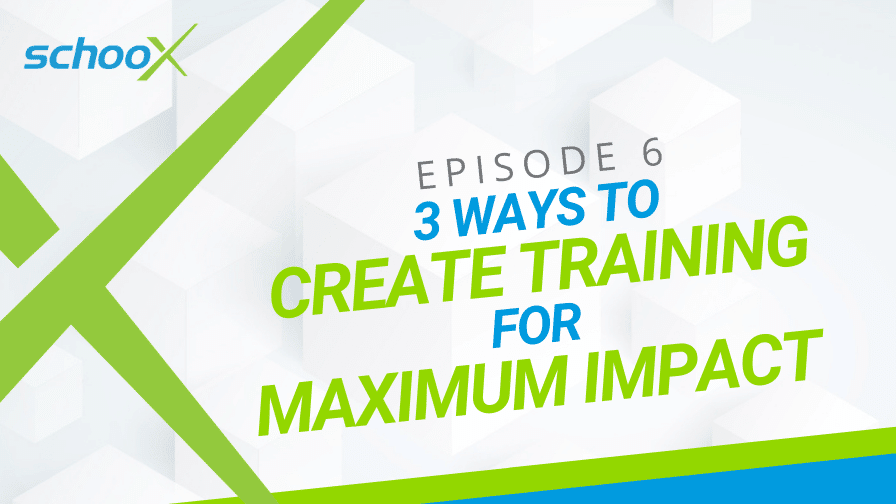November 13, 2020
4 Min. Read

If you’re an experienced L&D professional, you’ll have spent a good portion of your career designing training that leaves an impression on your learners. But what strategy do you use to make sure your learning experience impacts all learners to its maximum potential?
In this episode of The Learning Xchange, host Matthew Brown (Schoox’s VP of Learning and Brand Success) explores how to create a more impactful learning experience. You’ll discover his strategy for developing learning content and what you can do to go above and beyond the traditional models.
Listen to this episode of the podcast below:
Or, keep reading to learn how to build training for maximum impact.
How do you build training to impact your learners?
Do you use a strategy to build your training courses? If you do, what’s your core focus?
Successful learning experiences are those that connect with their learners. This doesn’t happen by accident. In fact, more experienced L&D professionals will build their courses with the learners at their core.
From this starting point, you can use a three-step strategy to develop a course that can impact your learners in the greatest possible way. The first step is to understand your learner’s skills. The second is to understand what kinds of learners you have. Finally, the third step is to establish a learning community.
1. Understand what skills you are impacting and why
When designing training for learners within a business, your training should center around developing the skills or key competencies within that business. These shared skills are a common language that you can use as a starting point to build training courses.
Understanding the organization’s existing competencies will help you to recognize when learners are meeting their goals. As a trainer, it’s vital that you take a step beyond simply taking into account training compliance. Go deeper. Ask questions like, how did this training help the learner meet their objective?
Once you can understand how training improves or changes learners within an organization, you can adapt or rebuild the training to influence those learners in new ways. Discovering how your training impacts learners is critical. It ensures that you can keep providing learning experiences that connect to your learners and benefit the business.
This proactive approach to building training requires a sustained amount of learner attention. And isn’t commonly practiced in the industry. However, this is a powerful, meaningful way to build training courses. It helps you shift from a reactive model to one where you can anticipate the specific learner needs and outcomes.
2. Understand how people learn
Understanding our learners is possibly the most important step of this strategy. When trainers know their learners, only then can they deliver truly impactful learning experiences.
If a learner consistently consumes training content in a way that they internalize knowledge, you might think that you’ve built a successful course. But, take that same course and give it to a different learner, and they might struggle to learn from it.
Not all learners learn in the same way. What’s a successful learning experience for one person might be a disaster for someone else. So, it’s important you take these different learning styles into consideration when you build training. There are eight different types of learner:
- Verbal learners prefer to learn through linguistic skills such as discussion
- Visual learners retain information more effectively with visual aids
- Musical or auditory learners benefit from sounds and rhythm
- Physical or kinesthetic learners favor a hands-on learning approach
- Logical or mathematical learners enjoy leveraging their sense of logic and reasoning
- Social learners focus better with group learning experiences
- Solitary learners like independent self-study
- Combination learners learn effectively using two or more of the previous styles in conjunction
Consider what learner types there are within your business. How can you build training that’s going to include them all? Doing so will provide you with the best chance to successfully impact your learners.
When you’re aware of the learning styles that you have to accommodate, you can build elements that suit each type in your training. For example, if you’re building a self-paced e-learning course, and you know that your learners are mostly verbal and visual, you could record your training lectures as a video and include captions so that people can read along.
There are many e-learning software features that can help other learners access your training better. For musical learners, you could put a music backing track onto your videos or your e-learning platform, with the option to turn the music on or off. For logical and physical learners, you could include quizzes, gamification, or interactive activities. While it might seem more challenging to design inclusive training for remote learning, the technology developments are making it increasingly possible.
3. Create learning communities
The final step for building more impactful training is to extend learning beyond the training course. The most impactful moments in face-to-face training are when social learning is happening, and relationships and communities form, so think about building this into your training.
Transferring knowledge and discussing ideas is one of the best ways to reinforce your learning. Trainers can facilitate this by creating a community. You could use a discussion board, online groups, or start an email exchange between learners to begin exploring some of the topics.
Initiating and encouraging conversation can make a big difference to your training’s impact. The training can be more memorable and continue to pay dividends for the learners in the future. If learners have problems or questions, their community can come together to share ideas and help.
Community is a huge part of learning and development. We can achieve far more together than we can apart.
Why build training using this strategy?
Building training with a strategy that has the learner at its core stands the most chances of success. By bringing together these three elements of skills, learner types, and communities, your content has the opportunity to make the maximum possible impact on your learners.
To maximize your training’s impact, we’d like to encourage you to plan how you can create a community for one of your learning activities. How could you make this a group task or find a space for discussing this topic?
If your LMS supports groups or discussion boards, this is the perfect place to start. If not, can you think of another virtual space or way of facilitating the conversation? Hopefully, this space can be a valuable extension of your learning experience, which continues to support and impact your learners.



